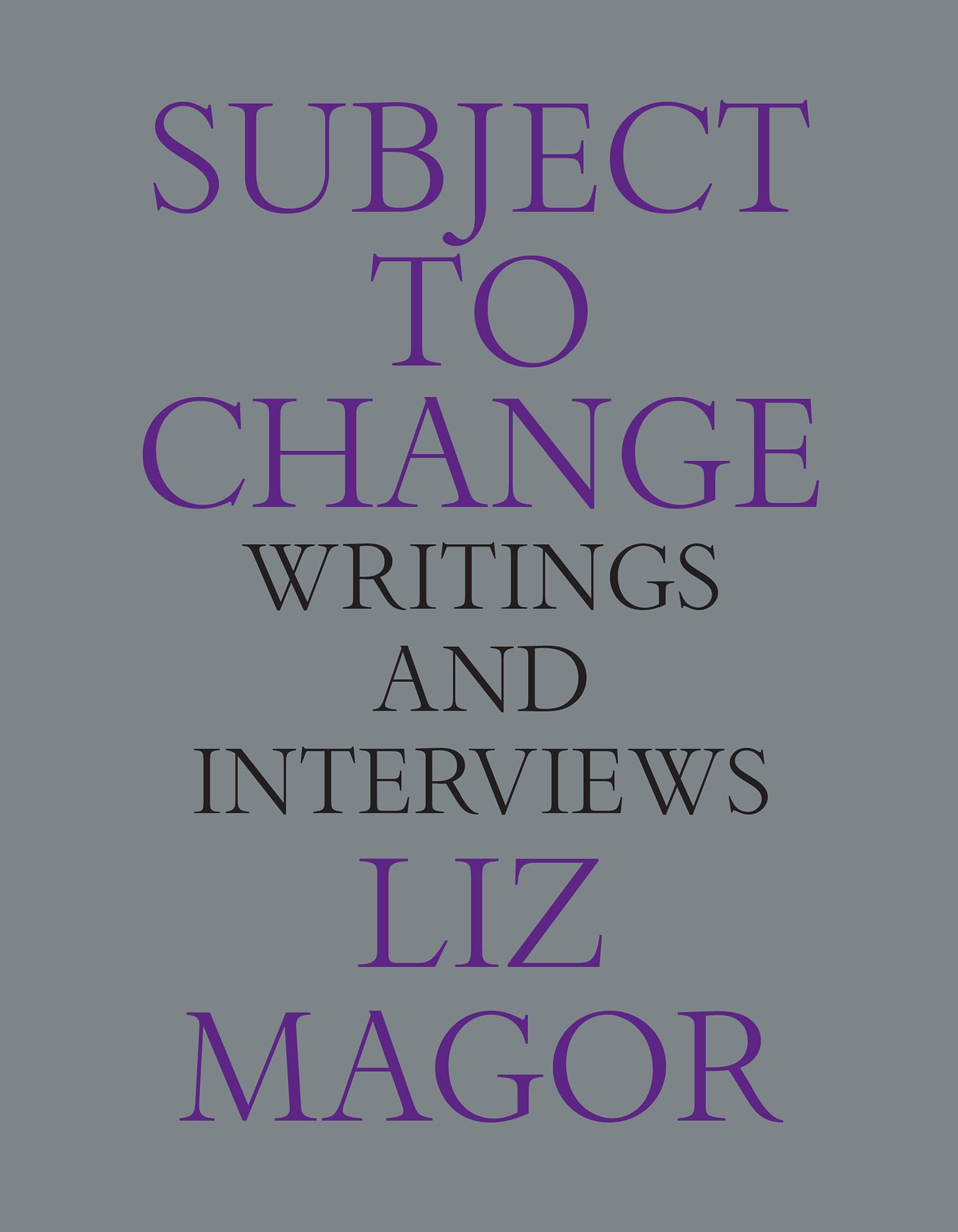SUBJECT TO CHANGE
Subject to Change
Writings and Interviews
LIZ MAGOR

Series: Text/Context: Writings by Canadian Artists
Subject to Change: Writings and Interviews brings together catalogue statements, essays, conversations, lecture notes, communications with gallerists and writers, and unpublished writings by Liz Magor, of the most important contemporary artists of the last fifty years. In addition to writings spanning more than four decades, the book features a preface by Magor, as well as an introductory essay by critic and curator Philip Monk.
A sculptor who replicates quotidian objects, often combining them with found ephemera or complicating their shape or size, Liz Magor prompts viewers of her sculptures to endow them with stories and histories of their own making. As a writer, Magor uses narrative to make sense of her own work, but she also returns to themes over the course of her career including subject/object relations and transformations; training systems for artists; consumption and commodification; human attachment and relationships; and complexities of time, place, and situation, particularly her own as a feminist artist in a settler-colonial society. Subject to Change is essential reading for anyone interested in Magor's practice, as well as broader questions in art since the 1970s.
"Liz Magor’s beautiful writing is as quietly mind-expanding as her artwork. Her texts are cinematic in their pacing, cutting between scenes, and in their canny, knowing descriptions of the physical world. Some of my favourites here are her lecture notes, conversations, and correspondence for the ways they place the writing in that physical world. But the surprising thing about this brilliant collection is that Magor’s writing is its own parallel universe, an expansive, heterodox place full of unexpected insights and experimentation."
Dan Byers, Robinson Family Director of the Carpenter Center for the Visual Arts at Harvard University
"I knew Liz Magor to be a protean thinker, warm and witty: still, none of this prepared me for the breadth and candour of Subject to Change. This most charismatic intellect moves through the prescriptive art world ‘corrections’ of the 1980s, to her inspirations from literature and anthropology, to the relationship of writing to art making, and most persistently, to ruminating the fundaments of a studio practice. This perspicacious collection is a deep dive into the workings of a visionary, supple mind and confirms Magor as one of the great artist-writers of our time."
Moyra Davey
"When I look at art, I need to be convinced that the artist has investigated their subject extensively and taken it as far as they can go. Liz Magor’s work fulfills this, and this collection of her writings goes further by laying bare her curiosity about the world. Here we get glimpses into how she generates her seductive practice. The reader is treated to the mind-expanding nature of her work--not to explain it, rather to enrich the experience."
Brian Jungen
"This is a powerful book; it is in motion. It is timeless and honest in its struggles and questions. The notes, essays, and statements show deep respect for the work but never pretend to be a neat package. Subject to Change takes readers close to the way Liz Magor thinks about her work, how she works, and how she submits to the real. It is fascinating to read pieces from decades ago and to see how relevant they are to Magor’s recent practice, as well to questions confronting the art world today."
Céline Kopp, Director & Chief Curator, Triangle France
Read on Manifold.
| Author’s Note | xi | |
| Introduction Worrying the World of Things |
Philip Monk | xv |
| What People Do for Work | 1 | |
| Production/Reproduction | 5 | |
| Like a Tune | 9 | |
| The Most She Weighed, The Least She Weighed | 13 | |
| Four Notable Bakers | 51 | |
| Liz Magor in Discussion with Ian Carr-Harris | 101 | |
| Pulp Fiction Presents the Special Collection | 131 | |
| On Mercer Union, Installation, Palaces, and Shelter | 137 | |
| Auto Portrait | 149 | |
| An Artist’s Throughts on Conservation and Curatorial Issues | 159 | |
| Statement for Siberian Husky | 167 | |
| Home and Native Land | 171 | |
| February 20, 1864 | 183 | |
| House Plant | 189 | |
| Maple Leaf Confectionery | 195 | |
| White House Paint | 201 | |
| Messenger | 207 | |
| Military Through the Ages | 213 | |
| Blue Students | 217 | |
| The Forces of Wolfe and Montcalm | 227 | |
| On Retreats and Fake Dogs | 231 | |
| The Lenticular | 241 | |
| Faint | 245 | |
| On Rita McBride | 251 | |
| Ancient Affections | 255 | |
| Therese Veh, 1902–1986 | 263 | |
| About Blankets; Kings and Queens | 267 | |
| Burn, Burn, Burn | 271 | |
| About Lethbridge Telegram | 285 | |
| Statement for The Capilano Review | 289 | |
| Poodles | 293 | |
| To Liz Mulholland | 297 | |
| Out Here | 301 | |
| A Conversation with Liz Magor | 305 | |
| Comment with Regard to the Sculptural Work Cupped | 319 | |
| To Ask Sheila Heti | 323 | |
| Stonecroft Lecture | 327 | |
| On an Eight-Sided Tlingit Box | 335 | |
| Buckle | 339 | |
| What Does Ambition Look Like, And What Form Does Failure Take? | 343 | |
| Entertaining the Contradiction | 347 | |
| Zero Things: Liz Magor Interviewed by Lee Ann Norman | 351 | |
| Spring/Summer 2020 | 357 | |









